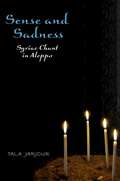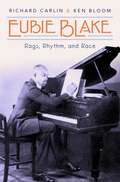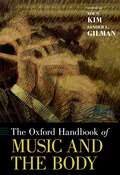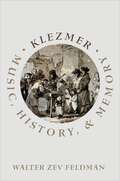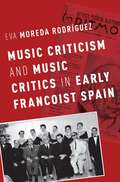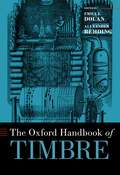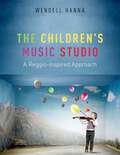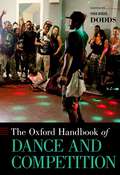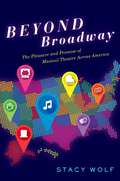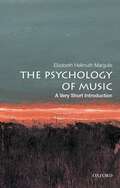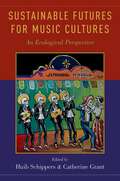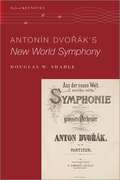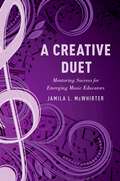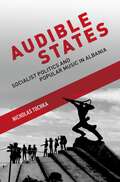- Table View
- List View
SENSE & SADNESS C: Syriac Chant in Aleppo
by Tala JarjourSense and Sadness is an innovative study of music modality in relation to human emotion and the aesthetics of perception. It is also a musical story of survival through difficulty and pain. Focusing on chant at St George's Syrian Orthodox Church of Aleppo, author Tala Jarjour puts forward the concept of the emotional economy of aesthetics, which enables a new understanding of modal musicality in general and of Syriac musicality in particular. Jarjour combines insights from musicology and ethnomusicology, sound and religious studies, anthropology, history, East Christian and Middle Eastern studies, and the study of emotion, to seamlessly weave together multiple strands of a narrative which then becomes the very story it tells. Drawing on imagination and metaphor, she brings to the fore overlapping, at times contradictory, modes of sense and sense making. At once intimate and analytical, this ethnographic text entwines academic thinking with its subject(s) and subjectivities, portraying events, writing, people, and music as they unfold together through ritual commemorations and a devastating, ongoing war.
Eubie Blake: Rags, Rhythm, and Race
by Richard Carlin Ken BloomA new biography of one of the key composers of 20th-century American popular song and jazz, Eubie Blake: Rags, Rhythm and Race illuminates Blake's little-known impact on over 100 years of American culture. A gifted musician, Blake rose from performing in dance halls and bordellos of his native Baltimore to the heights of Broadway. In 1921, together with performer and lyricist Noble Sissle, Blake created Shuffle Along which became a sleeper smash on Broadway eventually becoming one of the top ten musical shows of the 1920s. Despite many obstacles Shuffle Along integrated Broadway and the road and introduced such stars as Josephine Baker, Lottie Gee, Florence Mills, and Fredi Washington. It also proved that black shows were viable on Broadway and subsequent productions gave a voice to great songwriters, performers, and spoke to a previously disenfranchised black audience. As successful as Shuffle Along was, racism and bad luck hampered Blake's career. Remarkably, the third act of Blake's life found him heralded in his 90s at major jazz festivals, in Broadway shows, and on television and recordings. Tracing not only Blake's extraordinary life and accomplishments, Broadway and popular music authorities Richard Carlin and Ken Bloom examine the professional and societal barriers confronted by black artists from the turn of the century through the 1980s. Drawing from a wealth of personal archives and interviews with Blake, his friends, and other scholars, Eubie Blake: Rags, Rhythm and Race offers an incisive portrait of the man and the musical world he inhabited.
Eubie Blake: Rags, Rhythm, and Race
by Ken Bloom Richard CarlinA new biography of one of the key composers of 20th-century American popular song and jazz, Eubie Blake: Rags, Rhythm and Race illuminates Blake's little-known impact on over 100 years of American culture. A gifted musician, Blake rose from performing in dance halls and bordellos of his native Baltimore to the heights of Broadway. In 1921, together with performer and lyricist Noble Sissle, Blake created Shuffle Along which became a sleeper smash on Broadway eventually becoming one of the top ten musical shows of the 1920s. Despite many obstacles Shuffle Along integrated Broadway and the road and introduced such stars as Josephine Baker, Lottie Gee, Florence Mills, and Fredi Washington. It also proved that black shows were viable on Broadway and subsequent productions gave a voice to great songwriters, performers, and spoke to a previously disenfranchised black audience. As successful as Shuffle Along was, racism and bad luck hampered Blake's career. Remarkably, the third act of Blake's life found him heralded in his 90s at major jazz festivals, in Broadway shows, and on television and recordings. Tracing not only Blake's extraordinary life and accomplishments, Broadway and popular music authorities Richard Carlin and Ken Bloom examine the professional and societal barriers confronted by black artists from the turn of the century through the 1980s. Drawing from a wealth of personal archives and interviews with Blake, his friends, and other scholars, Eubie Blake: Rags, Rhythm and Race offers an incisive portrait of the man and the musical world he inhabited.
French Musical Culture and the Coming of Sound Cinema (Oxford Music/Media Series)
by Hannah LewisThe transition from silent to synchronized sound film was one of the most dramatic transformations in cinema's history, as it radically changed the technology, practices, and aesthetics of filmmaking within a few short years. In France, debates about sound cinema were fierce and widespread. In French Musical Culture and the Coming of Sound Cinema, author Hannah Lewis argues that the debates about sound film resonated deeply within French musical culture of the early 1930s, and conversely, that discourses surrounding a range of French musical styles and genres shaped audiovisual cinematic experiments during the transition to sound. Lewis' book focuses on many of the most prominent directors and screenwriters of the period, from Luis Buñuel to Jean Vigo, as well as experiments found in lesser-known films. Additionally, Lewis examines how early sound film portrayed the diverse soundscape of early 1930s France, as filmmakers drew from the music hall, popular chanson, modernist composition, opera and operetta, and explored the importance of musical machines to depict and to shape French audiovisual culture. In this light, the author discusses the contributions of well-known composers for film alongside more popular music hall styles, all of which had a voice within the heterogeneous soundtrack of French sound cinema. By delving into this fascinating developmental period of French cinematic history, Lewis encourages readers to challenge commonly-held assumptions about how genres, media, and artistic forms relate to one another, and how these relationships are renegotiated during moments of technological change.
FRENCH MUS CULT & COM SOUND CIN OMMS C (Oxford Music/Media Series)
by Hannah LewisThe transition from silent to synchronized sound film was one of the most dramatic transformations in cinema's history, as it radically changed the technology, practices, and aesthetics of filmmaking within a few short years. In France, debates about sound cinema were fierce and widespread. In French Musical Culture and the Coming of Sound Cinema, author Hannah Lewis argues that the debates about sound film resonated deeply within French musical culture of the early 1930s, and conversely, that discourses surrounding a range of French musical styles and genres shaped audiovisual cinematic experiments during the transition to sound. Lewis' book focuses on many of the most prominent directors and screenwriters of the period, from Luis Buñuel to Jean Vigo, as well as experiments found in lesser-known films. Additionally, Lewis examines how early sound film portrayed the diverse soundscape of early 1930s France, as filmmakers drew from the music hall, popular chanson, modernist composition, opera and operetta, and explored the importance of musical machines to depict and to shape French audiovisual culture. In this light, the author discusses the contributions of well-known composers for film alongside more popular music hall styles, all of which had a voice within the heterogeneous soundtrack of French sound cinema. By delving into this fascinating developmental period of French cinematic history, Lewis encourages readers to challenge commonly-held assumptions about how genres, media, and artistic forms relate to one another, and how these relationships are renegotiated during moments of technological change.
The Oxford Handbook of Music and the Body (Oxford Handbooks)
The presence of the phenomenological body is central to music in all of its varieties and contradictions. With the explosion of scholarly works on the body in virtually every field in the humanities, the social as well as the biomedical sciences, the question of how such a complex understanding of the body is related to music, with its own complexity, has been investigated within specific disciplinary perspectives. The Oxford Handbook of Music and the Body brings together scholars from across these fields, providing a platform for the discussion of the multidimensional interfaces of music and the body. The book is organized into six sections, each discussing a topic that defines the field: the moving and performing body; the musical brain and psyche; embodied mind, embodied rhythm; the disabled and sexual body; music as medicine; and the multimodal body. Connecting a wide array of diverse perspectives and presenting a survey of research and practice, the Handbook provides an introduction into the rich world of music and the body.
Klezmer: Music, History, and Memory
by Walter Zev FeldmanKlezmer: Music, History, and Memory is the first comprehensive study of the musical structure and social history of klezmer music, the music of the Jewish musicians' guild of Eastern Europe. Emerging in 16th century Prague, the klezmer became a central cultural feature of the largest transnational Jewish community of modern times - the Ashkenazim of Eastern Europe. Much of the musical and choreographic history of the Ashkenazim is embedded in the klezmer repertoire, which functioned as a kind of non-verbal communal memory. The complex of speech, dance, and musical gesture is deeply rooted in Jewish expressive culture, and reached its highest development in Eastern Europe. Klezmer: Music, History, and Memory reveals the artistic transformations of the liturgy of the Ashkenazic synagogue in klezmer wedding melodies, and presents the most extended study available in any language of the relationship of Jewish dance to the rich and varied klezmer music of Eastern Europe. Author Walter Zev Feldman expertly examines the major written sources--principally in Russian, Yiddish, Hebrew, and Romanian--from the 16th to the 20th centuries. He draws upon the foundational notated collections of the late Tsarist and early Soviet periods, as well as rare cantorial and klezmer manuscripts from the late 18th to the early 20th centuries. He has conducted interviews with authoritative European-born klezmorim over a period of more than thirty years, in America, Europe, and Israel. Thus, his analysis reveals both the musical and cultural systems underlying the klezmer music of Eastern Europe.
Music Criticism and Music Critics in Early Francoist Spain (Currents in Latin American and Iberian Music)
by Eva Moreda RodriguezThe early years of the Franco regime saw the formation of a strong governmental propaganda apparatus. Through expansive press laws that solidified state control over public and private media outlets alike, the Franco government directly influenced what information was made available to the public. While music critics and journalists were by no means free from government control and direction, music criticism under the Franco regime did not adhere to any official party "line" on music. Indeed, music criticism often demonstrated a diversity of opinion and ideological belief that runs counter to many common assumptions about journalism under fascist regimes. In Music Criticism and Music Critics in Early Francoist Spain, Eva Moreda Rodríguez presents a kaleidoscopic portrait of the diverse and often divergent writings of music critics in the early years of the Franco regime. Although she does not shy away from the thorny issues of propaganda and censorship, Moreda Rodríguez considers other factors that shaped the journalistic discourse surrounding music. Political rivalries, ideological diversity within musical "conservatism," as well as the explicit and implicit expectations of the Franco government all influenced the diverse landscape of music criticism. Moreover, the central issues that music critics were concerned with during Francoism's early years-modernist music, Spanish early music, traditional music, and music's role in organizing the state-had already been at the center of debates within the press for several decades. Carefully selecting contemporary writings by well-known music critics, Moreda Rodríguez contextualizes music criticism written during the Franco regime within the broader intellectual history of Spain from the nineteenth century onwards. The first critical study of the musical press of Francoist Spain in the broader cultural and social fabric of the regime, Music Criticism and Music Critics in Early Francoist Spain is an essential resource for musicologists interested in 20th-century Spain, as well as Hispanists interested in the early Franco regime.
The Oxford Handbook of Timbre (Oxford Handbooks)
by Emily I. Dolan Alexander RehdingDespite its importance as a central feature of musical sounds, timbre has rarely stood in the limelight. First defined in the eighteenth century, denigrated during the nineteenth, the concept of timbre came into its own during the twentieth century and its fascination with synthesizers and electronic music-or so the story goes. But in fact, timbre cuts across all the boundaries that make up musical thought-combining scientific and artistic approaches to music, material and philosophical aspects, and historical and theoretical perspectives. Timbre challenges us to fundamentally reorganize the way we think about music. The twenty-five essays that make up this collection offer a variety of engagements with music from the perspective of timbre. The boundaries are set as broad as possible: from ancient Homeric sounds to contemporary sound installations, from birdsong to cochlear implants, from Tuvan overtone singing to the tv show The Voice, from violin mutes to Moog synthesizers. What unifies the essays across this vast diversity is the material starting point of the sounding object. This focus on the listening experience is radical departure from the musical work that has traditionally dominated musical discourse since its academic inception in late-nineteenth-century Europe. Timbre remains a slippery concept that has continuously demanded more, be it more precise vocabulary, a more systematic theory, or more rigorous analysis. Rooted in the psychology of listening, timbre consistently resists pinning complete down. This collection of essays provides an invitation for further engagement with the range of fascinating questions that timbre opens up.
The Oxford Handbook of Timbre (Oxford Handbooks)
by Emily I. Dolan Alexander RehdingDespite its importance as a central feature of musical sounds, timbre has rarely stood in the limelight. First defined in the eighteenth century, denigrated during the nineteenth, the concept of timbre came into its own during the twentieth century and its fascination with synthesizers and electronic music-or so the story goes. But in fact, timbre cuts across all the boundaries that make up musical thought-combining scientific and artistic approaches to music, material and philosophical aspects, and historical and theoretical perspectives. Timbre challenges us to fundamentally reorganize the way we think about music. The twenty-five essays that make up this collection offer a variety of engagements with music from the perspective of timbre. The boundaries are set as broad as possible: from ancient Homeric sounds to contemporary sound installations, from birdsong to cochlear implants, from Tuvan overtone singing to the tv show The Voice, from violin mutes to Moog synthesizers. What unifies the essays across this vast diversity is the material starting point of the sounding object. This focus on the listening experience is radical departure from the musical work that has traditionally dominated musical discourse since its academic inception in late-nineteenth-century Europe. Timbre remains a slippery concept that has continuously demanded more, be it more precise vocabulary, a more systematic theory, or more rigorous analysis. Rooted in the psychology of listening, timbre consistently resists pinning complete down. This collection of essays provides an invitation for further engagement with the range of fascinating questions that timbre opens up.
Puccini's La Bohème (Oxford Keynotes)
by Alexandra WilsonGiacomo Puccini's La Bohème is one of the most frequently performed operas in the world. But how did it come to be so adored? In this book, author Alexandra Wilson traces La Bohème's rise to fame and demonstrates that its success grew steadily through stage performances, recordings, filmed versions and the endorsements of star singers. More recently, popular songs, film soundtracks and musicals that draw on the opera's music and themes added further to its immense cultural impact. This cultural history offers a fresh reading of a familiar work. Wilson argues that La Bohème's approach to realism and its flouting of conventions of the Italian operatic tradition made it strikingly modern for the 1890s. She explores how Puccini and his librettists engaged with gender, urban poverty and nostalgia--themes that grew out of the work's own time and continue to resonate with audiences more than 120 years later. Her analysis of the opera's depiction of Paris reveals that La Bohème was not only influenced by the romantic mythologies surrounding the city to this day but also helped shape them. Wilson's consideration of how directors have reinvented this opera for a new age completes this fascinating history of La Bohème, making it essential reading for anyone interested in this opera and the works it inspired.
PUCCINI'S LA BOHEME OKS C (Oxford Keynotes)
by Alexandra WilsonGiacomo Puccini's La Bohème is one of the most frequently performed operas in the world. But how did it come to be so adored? In this book, author Alexandra Wilson traces La Bohème's rise to fame and demonstrates that its success grew steadily through stage performances, recordings, filmed versions and the endorsements of star singers. More recently, popular songs, film soundtracks and musicals that draw on the opera's music and themes added further to its immense cultural impact. This cultural history offers a fresh reading of a familiar work. Wilson argues that La Bohème's approach to realism and its flouting of conventions of the Italian operatic tradition made it strikingly modern for the 1890s. She explores how Puccini and his librettists engaged with gender, urban poverty and nostalgia--themes that grew out of the work's own time and continue to resonate with audiences more than 120 years later. Her analysis of the opera's depiction of Paris reveals that La Bohème was not only influenced by the romantic mythologies surrounding the city to this day but also helped shape them. Wilson's consideration of how directors have reinvented this opera for a new age completes this fascinating history of La Bohème, making it essential reading for anyone interested in this opera and the works it inspired.
The Children's Music Studio: A Reggio-inspired Approach
by Wendell HannaThe Children's Music Studio provides music teachers, parents and early childhood educators a wealth of materials and a clear roadmap for applying Reggio Emilia principles and practices to preschool and early childhood music education. Drawing on Professor Hanna's extensive experience researching and teaching in Reggio-inspired music classrooms, this pioneering book provides a comprehensive and in-depth manual for designing music ateliers-hands-on studios that capture the imagination and creativity of children. Informed by the cutting edge research on music learning, this practical guide includes detailed studio plans, examples of Reggio-inspired music studio explorations and documentation of children's work in music studios. In this book you will: - Discover how children can naturally learn music through the studio approach - See detailed examples and documentation of project-based studio learning - Understand how music learning increases overall artistic and academic literacy across the curriculum - Learn how to develop customized projects for your classroom that will teach children to think and communicate fluently through music and sound Early childhood and elementary music teachers will find this book especially useful as it provides innovative ideas for Reggio-inspired music teaching and learning techniques that can be integrated into the existing curriculum.
The Oxford Handbook of Dance and Competition (Oxford Handbooks)
In the twenty-first century, values of competition underpin the free-market economy and aspirations of individual achievement shape the broader social world. Consequently, ideas of winning and losing, success and failure, judgment and worth, influence the dance that we see and do. Across stage, studio, street, and screen, economies of competition impact bodily aesthetics, choreographic strategies, and danced meanings. In formalized competitions, dancers are judged according to industry standards to accumulate social capital and financial gain. Within the capitalist economy, dancing bodies compete to win positions in prestigious companies, while choreographers hustle to secure funding and attract audiences. On the social dance floor, dancers participate in dance-offs that often include unspoken, but nevertheless complex, rules of bodily engagement. And the media attraction to the drama and spectacle of competition regularly plays out in reality television shows, film documentaries, and Hollywood cinema. Drawing upon a diverse collection of dances across history and geography, The Oxford Handbook of Dance and Competition asks how competition affects the presentation and experience of dance and, in response, how dancing bodies negotiate, critique, and resist the aesthetic and social structures of the competition paradigm.
The Oxford Handbook of Dance and Competition (Oxford Handbooks)
by Sherril DoddsIn the twenty-first century, values of competition underpin the free-market economy and aspirations of individual achievement shape the broader social world. Consequently, ideas of winning and losing, success and failure, judgment and worth, influence the dance that we see and do. Across stage, studio, street, and screen, economies of competition impact bodily aesthetics, choreographic strategies, and danced meanings. In formalized competitions, dancers are judged according to industry standards to accumulate social capital and financial gain. Within the capitalist economy, dancing bodies compete to win positions in prestigious companies, while choreographers hustle to secure funding and attract audiences. On the social dance floor, dancers participate in dance-offs that often include unspoken, but nevertheless complex, rules of bodily engagement. And the media attraction to the drama and spectacle of competition regularly plays out in reality television shows, film documentaries, and Hollywood cinema. Drawing upon a diverse collection of dances across history and geography, The Oxford Handbook of Dance and Competition asks how competition affects the presentation and experience of dance and, in response, how dancing bodies negotiate, critique, and resist the aesthetic and social structures of the competition paradigm.
Beyond Broadway: The Pleasure and Promise of Musical Theatre Across America
by Professor Stacy WolfThe idea of American musical theatre often conjures up images of bright lights and big city, but its lifeblood is found in amateur productions at high schools, community theatres, afterschool programs, summer camps, and dinner theatres. In Beyond Broadway, author Stacy Wolf looks at the widespread presence and persistence of musical theatre in U.S. culture, and examines it as a social practice--a live, visceral experience of creating, watching, and listening. Why does local musical theatre flourish in America? Why do so many Americans continue to passionately engage in a century-old artistic practice that requires intense, person-to-person collaboration? And why do audiences still flock to musicals in their hometowns? Touring American elementary schools, a middle school performance festival, afterschool programs, high schools, summer camps, state park outdoor theatres, community theatres, and dinner theatres from California to Tennessee, Wolf illustrates musical theatre's abundance and longevity in the U.S. as a thriving social activity that touches millions of lives.
BEYOND BROADWAY C: The Pleasure and Promise of Musical Theatre Across America
by Professor Stacy WolfThe idea of American musical theatre often conjures up images of bright lights and big city, but its lifeblood is found in amateur productions at high schools, community theatres, afterschool programs, summer camps, and dinner theatres. In Beyond Broadway, author Stacy Wolf looks at the widespread presence and persistence of musical theatre in U.S. culture, and examines it as a social practice--a live, visceral experience of creating, watching, and listening. Why does local musical theatre flourish in America? Why do so many Americans continue to passionately engage in a century-old artistic practice that requires intense, person-to-person collaboration? And why do audiences still flock to musicals in their hometowns? Touring American elementary schools, a middle school performance festival, afterschool programs, high schools, summer camps, state park outdoor theatres, community theatres, and dinner theatres from California to Tennessee, Wolf illustrates musical theatre's abundance and longevity in the U.S. as a thriving social activity that touches millions of lives.
The Psychology of Music: A Very Short Introduction (Very Short Introductions)
by Elizabeth Hellmuth MargulisMusic has been examined from multiple perspectives: as a product of human history, for example, or a product of human culture. But there is also a long tradition, intensified in recent decades, of thinking about music as a product of the human mind. Whether considering composition, performance, listening, or appreciation, the constraints and capabilities of the human mind play a formative role. The field that has emerged around this approach is known as the psychology of music. Written in a lively and accessible manner, this volume connects the science to larger questions about music that are of interest to practicing musicians, music therapists, musicologists, and the general public alike. For example: Why can one musical performance move an audience to tears, and another compel them to dance, clap, or snap along? How does a "hype" playlist motivate someone at the gym? And why is that top-40 song stuck in everyone's head? ABOUT THE SERIES: The Very Short Introductions series from Oxford University Press contains hundreds of titles in almost every subject area. These pocket-sized books are the perfect way to get ahead in a new subject quickly. Our expert authors combine facts, analysis, perspective, new ideas, and enthusiasm to make interesting and challenging topics highly readable.
The Psychology of Music: A Very Short Introduction (Very Short Introductions)
by Elizabeth Hellmuth MargulisMusic has been examined from multiple perspectives: as a product of human history, for example, or a product of human culture. But there is also a long tradition, intensified in recent decades, of thinking about music as a product of the human mind. Whether considering composition, performance, listening, or appreciation, the constraints and capabilities of the human mind play a formative role. The field that has emerged around this approach is known as the psychology of music. Written in a lively and accessible manner, this volume connects the science to larger questions about music that are of interest to practicing musicians, music therapists, musicologists, and the general public alike. For example: Why can one musical performance move an audience to tears, and another compel them to dance, clap, or snap along? How does a "hype" playlist motivate someone at the gym? And why is that top-40 song stuck in everyone's head? ABOUT THE SERIES: The Very Short Introductions series from Oxford University Press contains hundreds of titles in almost every subject area. These pocket-sized books are the perfect way to get ahead in a new subject quickly. Our expert authors combine facts, analysis, perspective, new ideas, and enthusiasm to make interesting and challenging topics highly readable.
SUSTAINABLE FUTURES FOR MUSIC CULTURES C: An Ecological Perspective
by Huib Schippers and Catherine GrantThe sustainability of music and other intangible expressions of culture has been high on the agenda of scholars, governments and NGOs in recent years. However, there is a striking lack of systematic research into what exactly affects sustainability across music cultures. By analyzing case studies of nine highly diverse music cultures against a single framework that identifies key factors in music sustainability, Sustainable Futures for Music Cultures offers an understanding of both the challenges and the dynamics of music sustainability in the contemporary global environment, and breathes new life into the previously discredited realm of comparative musicology, from an emphatically non-Eurocentric perspective. Situated within the expanding field of applied ethnomusicology, this book confirms some commonly held beliefs, challenges others, and reveals sometimes surprising insights into the dynamics of music cultures. By examining, comparing and contrasting highly diverse contexts from thriving to 'in urgent need of safeguarding,' Sustainable Futures for Music Cultures analyzes sustainability across five carefully defined domains. The book identifies pathways to strategies and tools that may empower communities to sustain and revitalize their music heritage on their terms. In this way, this book contributes to greater scholarly insight, new (sub)disciplinary approaches, and pathways to improved practical outcomes for the long-term sustainability of music cultures. As such it will be an essential resource for ethnomusicologists, as well as scholars and activists outside of music, with an interest in the preservation of intangible cultural heritage.
Antonín Dvo%rák's New World Symphony (Oxford Keynotes)
by Douglas W. ShadleBefore Antonín Dvorák's New World Symphony became one of the most universally beloved pieces of classical music, it exposed the deep wounds of racism at the dawn of the Jim Crow era while serving as a flashpoint in broader debates about the American ideals of freedom and equality. Drawing from a diverse array of historical voices, author Douglas W. Shadle's richly textured account of the symphony's 1893 premiere shows that even the classical concert hall could not remain insulated from the country's racial politics.
Antonín Dvo%rák's New World Symphony (Oxford Keynotes)
by Douglas W. ShadleBefore Antonín Dvorák's New World Symphony became one of the most universally beloved pieces of classical music, it exposed the deep wounds of racism at the dawn of the Jim Crow era while serving as a flashpoint in broader debates about the American ideals of freedom and equality. Drawing from a diverse array of historical voices, author Douglas W. Shadle's richly textured account of the symphony's 1893 premiere shows that even the classical concert hall could not remain insulated from the country's racial politics.
A Creative Duet: Mentoring Success for Emerging Music Educators
by Jamila McWhirterA Creative Duet: Mentoring Success for Emerging Music Educators offers new insights into music education mentoring. This book shows pre-service and early career music educators how to be proactive, innovative partners in the mentoring process. Author Jamila L. McWhirter gives expert guidance and practical tools to encourage emerging music educators to shape their own careers. Grounded in research and nearly three decades of experience as a music educator and music teacher educator, the book examines the collaborative and creative nature of the mentoring process and guides readers to the importance of informal, organic mentoring partnerships. Based upon an innovative approach, A Creative Duet is a book on how emerging music educators may gain the most from mentoring experiences while sharing and finding their own voice. Dr. McWhirter guides the reader through creative strategies, real-life examples and experiences, as well as introducing the thoughts and feelings of several emerging music educators concerning their mentoring experiences. She leads the reader through proactive preparation steps such as developing a personal mission statement, setting a course of action, examining the importance of establishing a time commitment to the mentoring relationship, as well as other aspects of self-exploration. A Creative Duet is an important book not only for the pre-service and early career music educator, but also for those involved in guiding future music educators.
CREATIVE DUET C: Mentoring Success for Emerging Music Educators
by Jamila McWhirterA Creative Duet: Mentoring Success for Emerging Music Educators offers new insights into music education mentoring. This book shows pre-service and early career music educators how to be proactive, innovative partners in the mentoring process. Author Jamila L. McWhirter gives expert guidance and practical tools to encourage emerging music educators to shape their own careers. Grounded in research and nearly three decades of experience as a music educator and music teacher educator, the book examines the collaborative and creative nature of the mentoring process and guides readers to the importance of informal, organic mentoring partnerships. Based upon an innovative approach, A Creative Duet is a book on how emerging music educators may gain the most from mentoring experiences while sharing and finding their own voice. Dr. McWhirter guides the reader through creative strategies, real-life examples and experiences, as well as introducing the thoughts and feelings of several emerging music educators concerning their mentoring experiences. She leads the reader through proactive preparation steps such as developing a personal mission statement, setting a course of action, examining the importance of establishing a time commitment to the mentoring relationship, as well as other aspects of self-exploration. A Creative Duet is an important book not only for the pre-service and early career music educator, but also for those involved in guiding future music educators.
AUDIBLE STATES C: Socialist Politics and Popular Music in Albania
by Nicholas TochkaDuring the Cold War, state-sponsored musical performances were central to the diplomatic agendas of the United States and the Soviet Union. But states on the periphery of the conflict also used state-funded performances to articulate their positions in the polarized global network. In Albania in particular, the postwar government invested heavily in public performances at home, effectively creating a new genre of popular music: the wildly popular light music. In Audible States: Socialist Politics and Popular Music in Albania, author Nicholas Tochka traces an aural history of Albania's government through a close examination of the development and reception of light music at Radio-Television Albania's Festival of Song. Drawing on a wide range of archival resources and over forty interviews with composers, lyricists, singers, and bureaucrats, Tochka describes how popular music became integral to governmental projects to improve society--and a major concern for both state-socialist and postsocialist regimes between 1945 and the present. Tochka's narrative begins in the immediate postwar period, arguing that state officials saw light music as a means to cultivate a modern population under socialism. As the Cold War ended, postsocialist officials turned again to light music, now hoping that these musicians could help shape Albania into a capitalist, "European" state. Interweaving archival research with ethnographic interviews, Audible States demonstrates that modern political orders do not simply render social life visible, but also audible. Incorporating insights from ethnomusicology, governmentality studies, and post-socialist studies, Audible States presents an original perspective on music and government that reveals the fluid, pervasive, but ultimately limited nature of state power in the modern world. A remarkably researched and engagingly written study, Audible States is a foundational text in the growing literature on popular music and culture in post-socialist Europe and will be of great interest for readers interested in popular music, sound studies, and the politics of the Cold War.
